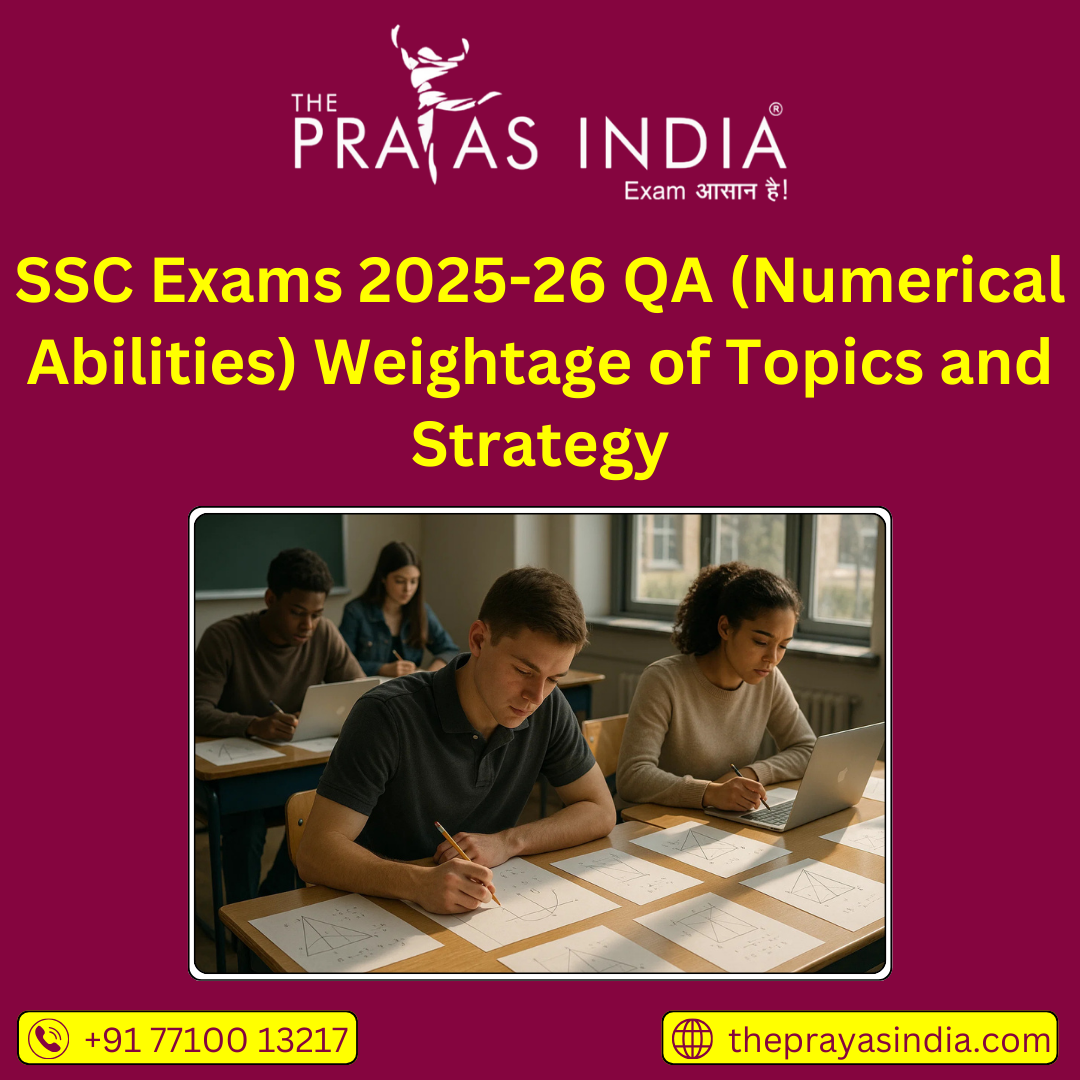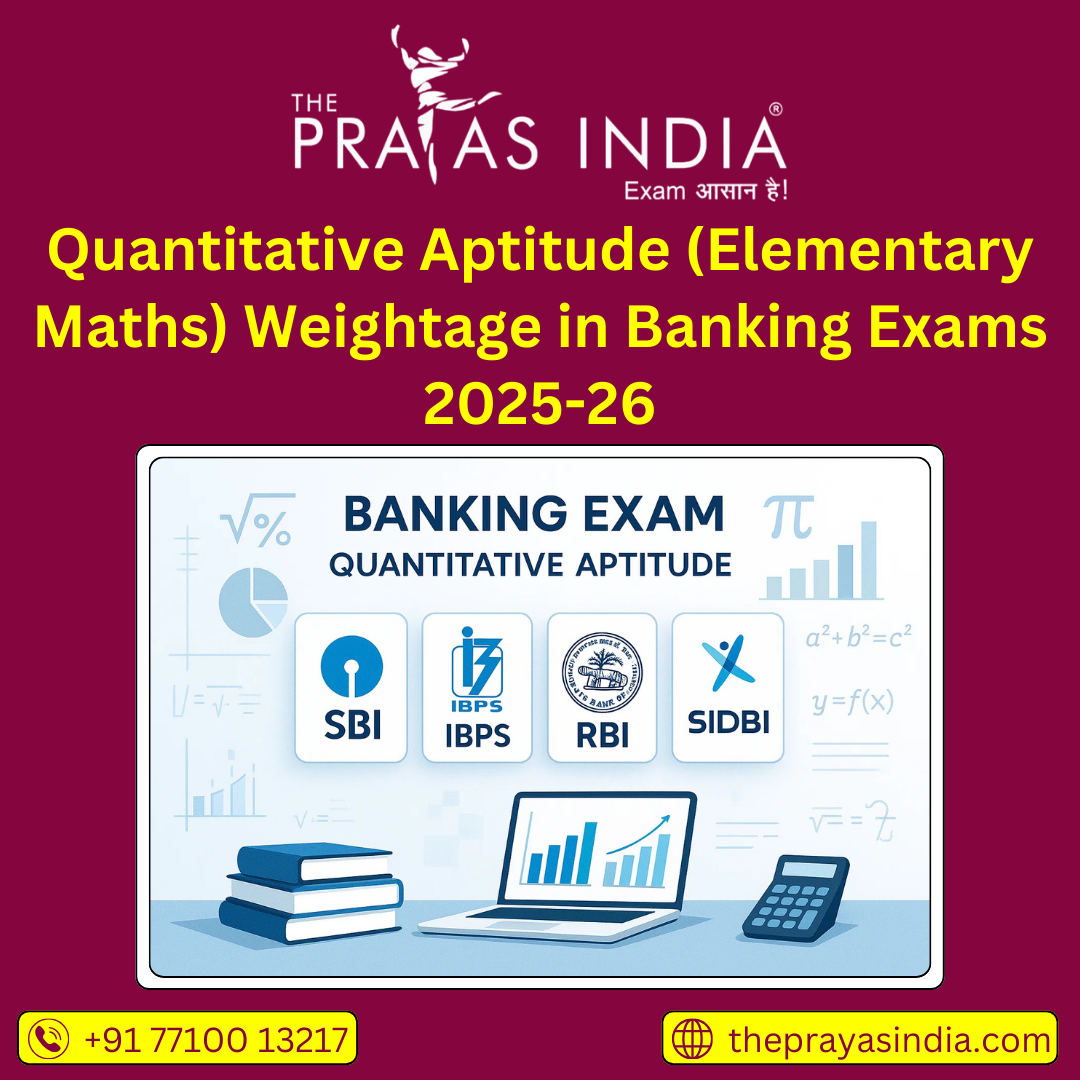SSC Exams 2025-26 QA (Numerical Abilities) Weightage of Topics and Strategy – Tier I & Tier II Preparation Strategy
Introduction
Quantitative Aptitude (QA), also called Numerical Abilities, is a deciding section in all major SSC exams—SSC CGL, CHSL, and CAPFs (CPO). It tests both speed and conceptual clarity across arithmetic, algebra, geometry, mensuration, trigonometry, and data interpretation.
Knowing the topic-wise weightage and latest syllabus helps aspirants focus preparation and maximize scores.
Below is a detailed and up-to-date breakdown for SSC CGL, CHSL, and CAPFs—the exam patterns, maths syllabus, topic-wise weightage, and an in-depth strategy for success.
https://online.theprayasindia.com/ssc/online-test-series
SSC Exams Unlimited Mock Tests
SSC CGL 2025-26: Exam Pattern & Mathematics Weightage
Exam Pattern
Tier 1 (Objective | 100 marks):
- Sections: General Intelligence & Reasoning, General Awareness, Quantitative Aptitude, English Comprehension
- Quantitative Aptitude (25 Qs, 50 marks)
- Duration: 60 minutes
Tier 2 (Objective | Advanced Maths)
- Paper I (Compulsory): Mathematical Abilities (30 Qs) | Reasoning (30 Qs) | English (45 Qs)
- Duration: 2 hours
SSC Exams Notices & Updates
Maths Syllabus Highlights
Covers:
- Arithmetic: Number System, Percentages, Ratio & Proportion, Averages, Profit & Loss, Time & Work, Time-Speed-Distance, SI-CI, Mixture & Alligation, Partnership
- Algebra: Identities, Surds, Equations
- Geometry: Lines, Angles, Triangles, Circle, Polygons, Congruence, Similarity
- Mensuration: 2D/3D shapes (Area, Volume)
- Trigonometry: Ratios, Heights & Distances, Identities
- Data Interpretation: Tables, Graphs, Pie Charts
- Statistics: Mean, Median, Mode, SD
- Probability
Topic-wise Weightage (Tier 1 Maths)
| Topic | No. of Questions (Range) |
|---|---|
| Average | 1 – 2 |
| Algebra | 1 – 2 |
| Geometry | 2 – 4 |
| Mensuration | 2 – 4 |
| Trigonometry | 1 – 4 |
| Data Interpretation | 3 – 6 |
| Ratio & Proportion | 0 – 2 |
| Number System | 1 – 2 |
| CI & SI | 0 – 2 |
| Profit, Loss & Discount | 1 – 3 |
| Mixture & Alligation | 0 – 3 |
| Time and Work | 1 – 2 |
| Speed, Time & Distance | 0 – 2 |
| Simplification | 1 – 2 |
| Partnership | 0 – 1 |
| Percentages | 0 – 1 |
Topic-wise Weightage (Tier 2 Mathematical Abilities)
| Topic | No. of Questions (Range) |
|---|---|
| Geometry | 9 – 15 |
| Data Interpretation | 5 – 10 |
| Average | 2 |
| Mixture & Alligation | 2 – 6 |
| Speed, Distance & Time | 4 – 8 |
| Percentage | 4 – 10 |
| Heights & Distance | 1 |
| Profit, Loss & Discount | 3 – 7 |
| Mensuration | 5 – 6 |
| Simplification | 4 – 6 |
| Trigonometry | 5 – 9 |
| Algebra | 3 – 6 |
| Number System | 5 – 6 |
| Ratio & Proportion | 1 – 3 |
| Time and Work | 3 – 4 |
| Partnership | 2 – 3 |
| Coordinate Geometry | 1 |
| SI & CI | 2 – 3 |
| Miscellaneous | 2 – 3 |
SSC CHSL 2025-26: Exam Pattern & Maths Weightage
Exam Pattern
Tier 1 (Objective | 100 marks):
- Sections: General Intelligence, Quantitative Aptitude, English, General Awareness
- QA: 25 Qs, 50 marks | Duration: 60 min
Tier 2
- Module-I: Mathematical Abilities (Objective)
- More advanced topics and skill-based modules
Maths Syllabus Highlights
- Number System, Operations, Percentages, Ratio & Proportion, Square roots, Averages, Interest, Profit & Loss, Discount, Partnership, Mixture & Alligation, Time & Distance, Time & Work, LCM-HCF
- Algebra, Basic identities, Surds, Graphs of Linear Equations
- Geometry, Triangles, Circle, Tangents, Polygons
- Mensuration (2D/3D shapes)
- Trigonometry, Ratios, Heights & Distances, Identities
- Data Interpretation: Tables, Graphs, Pie Charts
Topic-wise Weightage (Approx.)
| Topic | No. of Questions |
|---|---|
| Algebra | 2 – 3 |
| Average | 0 – 1 |
| Geometry | 2 – 3 |
| Interest | 1 – 2 |
| Mensuration | 2 – 3 |
| Profit and Loss | 2 – 3 |
| Number System | 1 – 2 |
| Percentage | 1 – 2 |
| Simplification | 1 – 2 |
| Speed Time Distance | 1 – 2 |
| Time and Work | 1 – 2 |
| Trigonometry | 2 – 3 |
| Data Interpretation | 1 – 2 |
| Miscellaneous | ~3 |
SSC CAPFs (CPO) 2025-26: Exam Pattern & Maths Weightage
Exam Pattern
Paper 1 (General Aptitude Test | 200 marks)
- Sections: General Intelligence, General Awareness, Quantitative Aptitude, English Comprehension
- Quantitative Aptitude: 50 Qs, 50 marks
Paper 2: English Language & Comprehension
- Negative marking of 0.25 for wrong answers.
Maths Syllabus Highlights
- Number Systems, Computation of Whole Numbers, Decimals and Fractions, Relationship between numbers
- Fundamental Arithmetical Operations: Percentage, Ratio & Proportion, Square roots, Averages, Interest, Profit & Loss, Discount, Partnership, Mixture, Time & Distance, Time & Work
- Algebra, Geometry, Mensuration (Triangle, Circle, Prism, Sphere, Cone, Cylinder, Parallelepiped, Pyramid), Trigonometry, Data Interpretation
- Miscellaneous: Pie Charts, Bar Diagrams, Histograms
Topic-wise Weightage (Indicative)
| Topic | Expected Weightage (Qs) |
|---|---|
| Number System | 4 – 6 |
| Algebra | 4 – 6 |
| Percentage | 2 – 4 |
| Average | 2 – 4 |
| Ratio & Proportion | 2 – 4 |
| SI & CI | 2 – 4 |
| Profit & Loss | 2 – 4 |
| Time & Distance | 3 – 5 |
| Mixture & Alligation | 2 – 4 |
| Simplification | 3 – 5 |
| Data Interpretation | 3 – 5 |
| Geometry & Mensuration | 6 – 10 |
| Time & Work | 2 – 4 |
| Trigonometry | 3 – 5 |
| Miscellaneous | 2 – 3 |
Preparation Strategy for Maths (QA) — The Prayas India Approach
1. Trend Analysis & Focus Areas
- Prioritize high-weightage topics: Geometry, Mensuration, DI, Algebra, Trigonometry, and Arithmetic
- Analyze previous year papers to spot recurring concepts.
- Practice most important formulas, standard identities, and short tricks.
2. Concept Clarity & Revision
- Strengthen basics from NCERT (Class 6–10) for all chapters.
- Regular revision schedules for formulae, identities, and quick calculations.
- Attempt all types of questions from each topic, from easy to difficult.
3. Speed & Accuracy
- Daily practice of sectional tests and topic-wise quizzes to improve pace.
- Emphasize unit conversions, Vedic math techniques, and mental calculations.
- Master problem-solving shortcuts, especially for arithmetic and DI.
4. Mock Exams & PYQ Analysis
- Routinely solve full-length SSC mock tests in simulated exam conditions.
- Analyze mocks for mistakes and maintain a separate error notebook.
- Regularly solve previous years’ SSC CGL, CHSL, CAPFs Maths papers.
5. Advanced Practice & Application
- For Tier 2/Modules, practice high-level DI, advanced mensuration, tricky geometry & algebra, and multi-concept problems.
- Go for mixed-topic practice sets to train on application questions.
6. The Prayas India Mentorship
- Personalized study plans based on strengths, weaknesses, and time available.
- “Smart Revision” sessions—focus on high-yield topics and common traps.
- Video sessions for hardest topics, shortcut classes, and doubt-clearing webinars.
- Regular update on SSC notifications, exam trends, and expected patterns.
SSC Exams (CGL/CHSL/CPOs/C & D/MTS) Cutoffs & Previous Year`s Comprehensive Analysis
7. Motivation & Discipline
- Set realistic daily/weekly targets and monitor progress.
- Use The Prayas India community (batch groups, webinars) for peer support and strategy feedback.
- Celebrate small wins—accuracy milestones, speed improvement—to stay motivated.
Conclusion
Quantitative Aptitude is the scoring backbone of all SSC exams—CGL, CHSL, CAPFs (CPO). By mastering the latest syllabus, understanding topic-wise weightage, and following a strategic, focused preparation approach, aspirants can maximize their SSC Maths scores.
At The Prayas India, candidates receive expert mentorship, targeted resources, and thorough practice support, ensuring their preparation remains smart, efficient, and result-oriented for all SSC exams in 2025–26.








